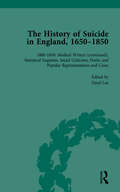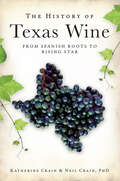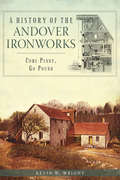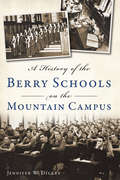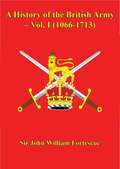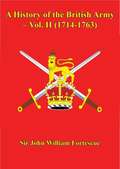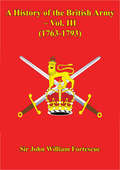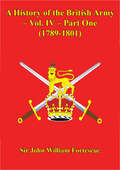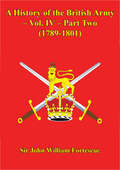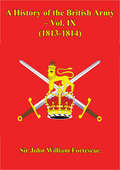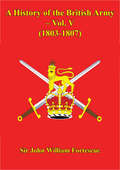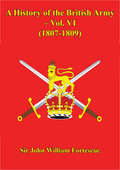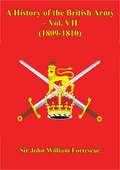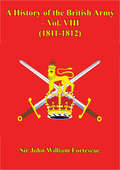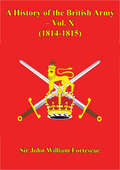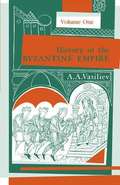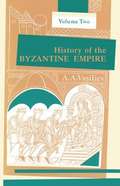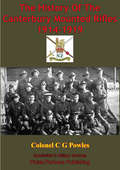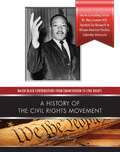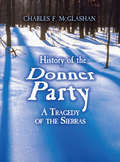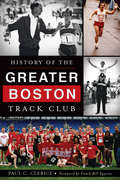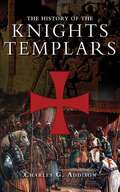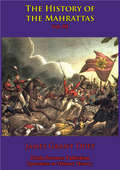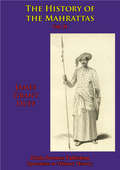- Table View
- List View
The History of Suicide in England, 1650–1850, Part II vol 8
by Mark Robson Paul S Seaver Kelly McGuire Jeffrey Merrick Daryl LeeFirst published in 2013. This two-part, eight-volume, reset edition draws together a range of sources from the early modern era through to the industrial age, to show the changes and continuities in responses to the social, political, legal and spiritual problems that self-murder posed. Part II, Volume 8 contains 1800–1850: Medical Writers (continued), Statistical Inquiries, Social Criticism, Poetic and Popular Representations and Cases.
The History of Texas Wine: From Spanish Roots to Rising Star (American Palate Ser.)
by Katherine Crain Neil CrainSample the untold history of Texas&’s wine industry in this book filled with fascinating stories and photos. Spanish colonists may have come to Texas to spread Christianity, but under visionary Father Fray Garcia, they stayed and raised grapes. Later immigrants brought their own burgundy tastes of home, creating a unique wine country. When a North American pest threatened European vines, it was Texan scientist T. V. Munson who helped save the industry overseas. When Prohibition loomed stateside, Frank Qualia's Val Verde Winery in Del Rio survived by selling communion wine—and it&’s now the longest-operating bonded winery in the state. Today, tourists flock to Texas vineyards, and the state sells more wine every year. Join local experts Kathy and Neil Crain and sample the untold story of Texas's wine industry, a 350-year story that is still reaching its savory peak.
A History of the Andover Ironworks: Come Penny, Go Pound
by Kevin W. WrightSoon after Philadelphia began to exploit New Jersey's largest hematite deposit in 1758, Andover Furnace and Forge began producing the best metal in the world. Its product was so desirable that the newly formed American military wrested control from Loyalist owners in 1778. This frontier industrial outpost endured thirty-five years before labor costs, competition from cheap imports, careless consumption of woodlands and difficulty in transporting its products finally extinguished its fires. Today, repurposed eighteenth-century stone mills and mansions at Andover and Waterloo testify to the combination of rich ore, abundant water power and seemingly endless forests that long ago attracted teamsters, woodcutters, charcoal burners, miners, molders and smelters to the Appalachian Highlands of New Jersey. Local expert Kevin Wright tells the hidden story of the facets and personalities that once made Andover iron so widely coveted.
A History of the Berry Schools on the Mountain Campus
by Jennifer DickeyAt the dawn of the twentieth century, Martha Berry had a vision that a residential school for young men and women with limited educational opportunities would help break the cycle of poverty that pervaded the rural South. She began an educational experiment in northwest Georgia that unfolded during her lifetime and continues into the twenty-first century. This book tells the story of a part of that school--the high school that existed on the Mountain Campus at Berry for more than six decades. For the students who were educated there, the school was transformative. As one alumnus explained, the school had about it an "intangible magic." Join author and Berry Academy alumna Jennifer Dickey as she captures the spirit of that school that today lives on in the "head, heart and hands" of its graduates.
A History of the British Army – Vol. I (A History of the British Army #1)
by Sir John William FortescueSir John Fortescue holds a pre-eminent place amongst British military historians, his enduring fame and legacy resting mainly on his life's work "The History of the British Army", issued in 20 volumes, which took him some 30 years to complete. In scope and breadth it is such that no modern scholar has attempted to cover such a large and diverse subject in its entirety; but Sir John did so with aplomb, leading to a readable and comprehensive study.According to Professor Emeritus of Military History at King's College, Brian Bond, the work was "the product of indefatigable research in original documents, a determination to present a clear, accurate, and readable narrative of military operations, and a close personal knowledge of the battlefields, which enabled him to elucidate his account with excellent maps. Most important, however, was his motivation: namely, a lifelong affection for the old, long-service, pre-Cardwell army, the spirit of the regiments of which it largely consisted, and the value of its traditions to the nation. An important part of his task was to distil and inculcate these soldierly virtues which, in his conservative view, contrasted sharply with the unedifying character of politicians who habitually meddled in military matters." ODNB.This first volume covers the period from the battle of Hastings in 1066 to the end of the Seven Year's War in 1713. It includes the battles at Bannockburn, Crecy, Agincourt, Flodden, the battles of the English Civil War, Dunkirk Dunes, Tangiers, and the battles during Marlborough's campaigns. The volume also traces the development of European Armies, infantry, cavalry and artillery, and the specific changes in Britain during the period.A MUST READ for any military enthusiast.Author -- Fortescue, J. W. Sir, 1859-1933.Text taken, whole and complete, from the second edition published in 1910, London, by Macmillan and Co.Original Page Count - XXXV and 593 pages.Illustrations -- Numerous.
A History of the British Army – Vol. II (A History of the British Army #2)
by Sir John William FortescueSir John Fortescue holds a pre-eminent place amongst British military historians, his enduring fame and legacy resting mainly on his life's work "The History of the British Army", issued in 20 volumes, which took him some 30 years to complete. In scope and breadth it is such that no modern scholar has attempted to cover such a large and diverse subject in its entirety; but Sir John did so and with aplomb, leading to a readable and comprehensive study.According to Professor Emeritus of Military History at King's College, Brian Bond, the work was "the product of indefatigable research in original documents, a determination to present a clear, accurate, and readable narrative of military operations, and a close personal knowledge of the battlefields, which enabled him to elucidate his account with excellent maps. Most important, however, was his motivation: namely, a lifelong affection for the old, long-service, pre-Cardwell army, the spirit of the regiments of which it largely consisted, and the value of its traditions to the nation. An important part of his task was to distil and inculcate these soldierly virtues which, in his conservative view, contrasted sharply with the unedifying character of politicians who habitually meddled in military matters." ODNB.This second volume covers the period from 1713 to 1763, including the Jacobite rebellion of 1715, the wars of Austrian Succession, and British expansion into America and India and the enduring struggle with France for Imperial power.A MUST READ for any military enthusiast.Author -- Fortescue, J. W. Sir, 1859-1933.Text taken, whole and complete, from the second edition published in 1910, London, by Macmillan and Co.Original Page Count - xxii and 606 pages.Illustrations -- Numerous maps and plans
A History Of The British Army – Vol. III (A History of the British Army #3)
by Hon. Sir John William FortescueSir John Fortescue holds a pre-eminent place amongst British military historians, his enduring fame and legacy resting mainly on his life's work "The History of the British Army",According to Professor Brian Bond, the work was "the product of indefatigable research in original documents, a determination to present a clear, accurate, and readable narrative of military operations, and a close personal knowledge of the battlefields, which enabled him to elucidate his account with excellent maps. Most important, however, was his motivation: namely, a lifelong affection for the old, long-service, pre-Cardwell army, the spirit of the regiments of which it largely consisted, and the value of its traditions to the nation. An important part of his task was to distil and inculcate these soldierly virtues which, in his conservative view, contrasted sharply with the unedifying character of politicians who habitually meddled in military matters." ODNB.This third volume covers the period from 1763-1793, the European Powersfought each other via proxy but great vigour in North America and India. The British Army would have great success in India under military leaders of the calibre of Abercromby, Cornwallis and Warren Hastings. however the loss of the American Revolutionary War, gained for the Americans their Independence and the British troops, hamstrung by political foolishness, a humbling defeat.TIMES.--"Whatever Mr. Fortescue may do in the future, he has already, in his first three volumes, produced one of the most important military works in the English language. It is sincerely to be hoped that they will be read as widely as they deserve to be."ARMY AND NAVY GAZETTE.--"The Hon. J. W. Fortescue is greatly to be congratulated upon the third volume of his very important History of the British Army....With the publication of this book the British Army is gaining a complete history really worthy of the name."A MUST READ for any military enthusiast.
A History Of The British Army – Vol. IV – Part One (A History of the British Army #4)
by Hon. Sir John William FortescueSir John Fortescue holds a pre-eminent place amongst British military historians, his enduring fame and legacy resting mainly on his life's work "The History of the British Army", issued in 20 volumes, which took him some 30 years to complete. In scope and breadth it is such that no modern scholar has attempted to cover such a large and diverse subject in its entirety; but Sir John did so and with aplomb, leading to a readable and comprehensive study.This fourth volume covers the period from 1789 to 1801; as the tocsins of the French Revolution rang around the European continent their effects would lead to almost unceasing warfare for the next twenty years. During the Revolutionary Wars, the British Army would mature during the campaigns of the First Coalition against France always giving a good account of themselves, but their small number meant that the course of the campaign would not lead to victory. The effectiveness of the British Army in sea-borne assaults on French possessions across the world, would lead to much success but also bitter grumbling of Britain's coalition partners.TIMES.--"We are witnessing the birth of a military classic which is, and will be for some generations to come, without a peer in the subject to which it relates. The debt which the British Army owes to the writer of this moving chronicle of its great achievements, its grandeurs, and its miseries can only be repaid if every member of the Army endeavours to assimilate for himself, and for the profit of his country, Mr. Fortescue's admirable and most instructive pages."A MUST READ for any military enthusiast.
A History Of The British Army – Vol. IV – Part Two (A History of the British Army #5)
by Hon. Sir John William FortescueSir John Fortescue holds a pre-eminent place amongst British military historians, his enduring fame and legacy resting mainly on his life's work "The History of the British Army", issued in 20 volumes, which took him some 30 years to complete. In scope and breadth it is such that no modern scholar has attempted to cover such a large and diverse subject in its entirety; but Sir John did so and with aplomb, leading to a readable and comprehensive study.This fourth volume covers the period from 1789 to 1801; as the tocsins of the French Revolution rang around the European continent their effects would lead to almost unceasing warfare for the next twenty years. During the Revolutionary Wars, the British Army would mature during the campaigns of the First Coalition against France always giving a good account of themselves, but their small number meant that the course of the campaign would not lead to victory. The effectiveness of the British Army in sea-borne assaults on French possessions across the world, would lead to much success but also bitter grumbling of Britain's coalition partners.TIMES.--"We are witnessing the birth of a military classic which is, and will be for some generations to come, without a peer in the subject to which it relates. The debt which the British Army owes to the writer of this moving chronicle of its great achievements, its grandeurs, and its miseries can only be repaid if every member of the Army endeavours to assimilate for himself, and for the profit of his country, Mr. Fortescue's admirable and most instructive pages."A MUST READ for any military enthusiast.
A History Of The British Army – Vol. IX – (A History of the British Army #10)
by Hon. Sir John William FortescueSir John Fortescue holds a pre-eminent place amongst British military historians, his enduring fame and legacy resting mainly on his life's work "The History of the British Army", issued in 20 volumes, which took him some 30 years to complete. In scope and breadth it is such that no modern scholar has attempted to cover such a large and diverse subject in its entirety; but Sir John did so and with aplomb, leading to a readable and comprehensive study.This ninth volume covers the period from 1813-1814, after a bloody struggle the Duke of Wellington finally cleared the border fortress at Ciudad Rodrigo and Badajoz having laid siege to them more than once he set his victorious British and Portuguese troops on to the task of destroying the French armies before them in a piecemeal fashion. As can well be followed in Fortescue's masterly volume the advance of the British forces leavers the French forces out of numerous river protected positions before converging and destroying on the armies of the Centre and the North at the battle of Vitoria. Despite great ineptitude in the east of Spain, Wellington drove the French before him and into the Pyrenees, leading to a number of vicious engagements around the mountains through which the British Troops emerged victorious. However in North America the fighting was becoming desperate including bloody reverse at Sackett's Harbour, but ultimately the British and Canadian forces would fight to a honourable peace after the disastrous attack on New Orleans in 1815 [this battle is covered in the next volume].TIMES.--"We have in these volumes the worthy continuation of a history which is worthy of its subject. Mr. Fortescue will not ask for higher praise."
A History Of The British Army – Vol. V – (A History of the British Army #6)
by Hon. Sir John William FortescueSir John Fortescue holds a pre-eminent place amongst British military historians, his enduring fame and legacy resting mainly on his life's work "The History of the British Army", issued in 20 volumes, which took him some 30 years to complete. In scope and breadth it is such that no modern scholar has attempted to cover such a large and diverse subject in its entirety; but Sir John did so and with aplomb, leading to a readable and comprehensive study.This fifth volume covers the period from 1803-1807, following the short-lived Peace of Amiens Britain and her army faced their most inveterate and dangerous foe, Napoleon. However Britain stood alone against a resurgent France, her former allies had made a grudging peace with France and were unwilling to commit to Britain who they saw as self-interested. Napoleon encamped his huge army around the Channel ports and set about training for the invasion of Britain, the British Army was enlarged through many differing schemes awaiting the defence of the island. In the wider world the superiority of the British Navy enabled more colonial raiding whilst French positions in India were conquered.SPECTATOR.--"The new volumes of A History of the British Army are of the same high quality as those which have gone before. We can give no higher praise, for Mr. Fortescue can only be compared with himself. He has no rivals as a student of military history, and we question whether he has any living superior as an historian."A MUST READ for any military enthusiast.
A History Of The British Army – Vol. VI – (A History of the British Army #7)
by Hon. Sir John William FortescueSir John Fortescue holds a pre-eminent place amongst British military historians, his enduring fame and legacy resting mainly on his life's work "The History of the British Army", issued in 20 volumes, which took him some 30 years to complete. In scope and breadth it is such that no modern scholar has attempted to cover such a large and diverse subject in its entirety; but Sir John did so and with aplomb, leading to a readable and comprehensive study.According to Professor Emeritus of Military History at King's College, Brian Bond, the work was "the product of indefatigable research in original documents, a determination to present a clear, accurate, and readable narrative of military operations, and a close personal knowledge of the battlefields, which enabled him to elucidate his account with excellent maps. Most important, however, was his motivation: namely, a lifelong affection for the old, long-service, pre-Cardwell army, the spirit of the regiments of which it largely consisted, and the value of its traditions to the nation. An important part of his task was to distil and inculcate these soldierly virtues which, in his conservative view, contrasted sharply with the unedifying character of politicians who habitually meddled in military matters." ODNB.This sixth volume covers the period from 1807-1809, particularly the initial stages of involvement of the British Army in the struggle in the Iberian Peninsular. Written as always with superb detail and authority, Sir John details the opening of the British campaigns in Portugal, the battles at Roliça and Vimiero, before the brutal retreat and battle of Sir John Moore at Coruña.SPECTATOR.--"The new volumes of A History of the British Army are of the same high quality as those which have gone before. We can give no higher praise, for Mr. Fortescue can only be compared with himself. "A MUST READ for any military enthusiast.
A History Of The British Army – Vol. VII – (A History of the British Army #8)
by Hon. Sir John William FortescueSir John Fortescue holds a pre-eminent place amongst British military historians, his enduring fame and legacy resting mainly on his life's work "The History of the British Army", issued in 20 volumes, which took him some 30 years to complete. In scope and breadth it is such that no modern scholar has attempted to cover such a large and diverse subject in its entirety; but Sir John did so and with aplomb, leading to a readable and comprehensive study.According to Professor of Military History Brian Bond, the work was "the product of indefatigable research in original documents, a determination to present a clear, accurate, and readable narrative of military operations, and a close personal knowledge of the battlefields, which enabled him to elucidate his account with excellent maps. Most important, however, was his motivation: namely, a lifelong affection for the old, long-service, pre-Cardwell army, the spirit of the regiments of which it largely consisted, and the value of its traditions to the nation. An important part of his task was to distil and inculcate these soldierly virtues which, in his conservative view, contrasted sharply with the unedifying character of politicians who habitually meddled in military matters." ODNB.This seventh volume covers the period from 1809-1810, after a disastrous raid into French held Holland, the British government decided to use all their power to the strike at Napoleon at his weakest point, Portugal and Spain. After the British foray into Spain in 1809 culminating the bloody victory at Talavera, the British troops retreated into Portugal before the overwhelming French numbers. Inflicting a punishing check to the French invasion force under Masséna at Bussaco, the British army marched to the massive and impenetrable lines of Torres Vedras close to Lisbon.BROAD ARROW.--"This is a worthy successor to the volumes which have preceded it, and the whole forms a great work by a great, an impartial, and a bold writer,"
A History Of The British Army – Vol. VIII – (A History of the British Army #9)
by Hon. Sir John William FortescueSir John Fortescue holds a pre-eminent place amongst British military historians, his enduring fame and legacy resting mainly on his life's work "The History of the British Army", issued in 20 volumes, which took him some 30 years to complete. In scope and breadth it is such that no modern scholar has attempted to cover such a large and diverse subject in its entirety; but Sir John did so and with aplomb, leading to a readable and comprehensive study.This eight volume covers the period from 1811-12, having drawn the invading French forces into a trap before the fortified lines of Torres Vedras the British Army under Wellington set about expelling his foe from the land of his Portuguese allies. Despite much skill and bravery on the part of their French foes, the Duke of Wellington and his British troops pushed them back in some disarray and with heavy loss. The French however regrouped quickly and almost inflicted a serious reverse on the British forces at the battle of Fuentes d'Oñoro, but the determined resistance of the British army ensured that the French would never return to Portugal as anything other than as prisoners of war. Sir John does not miss the actions and manoeuvres in the other provinces of Spain, French successes in the east were balanced by losses in the south at the battle of Barossa and the failed siege of Tarifa. Across the Atlantic British naval high-handedness allied with American opportunism began to simmer over into the War of 1812 as the British would be caught fighting on two fronts and their Canadian citizens would face annexation into the United States. Written as always with superb detail and authority, Fortescue blends the political machinations with the movements of the British Armies across the globe and the glory gained by the troops in Spain and Portugal.ARMY AND NAVY GAZETTE.--"The whole volume is admirable; it is equally the work of a great student and of an impartial historian."A MUST READ for any military enthusiast.
A History Of The British Army – Vol. X – (A History of the British Army #11)
by Hon. Sir John William FortescueSir John Fortescue holds a pre-eminent place amongst British military historians, his enduring fame and legacy resting mainly on his life's work "The History of the British Army", issued in 20 volumes, which took him some 30 years to complete. In scope and breadth it is such that no modern scholar has attempted to cover such a large and diverse subject in its entirety; but Sir John did so and with aplomb, leading to a readable and comprehensive study.This tenth volume covers the period from 1814-1815, as the British Army along with its Portuguese and Spanish Allies finally pushed into France in 1814 they still met with fierce and determined resistance from the French troops under the veteran Marshal Soult. After a number of skilful, and some less skilful actions along the river lines the victories of the British troops added further evidence to the hopeless situation for Napoleon who abdicated in 1814. The British government immediately sent a large part of the victorious Peninsular army on a foolish and unsuccessful attack of New Orleans, all the more futile as peace had already been signed between the United States and Great Britain. Napoleon did not rest long in his new home on the Isle of Elba, returning to France in 1815 reuniting his enemies against him and fighting the era defining battle of Waterloo, one of the finest hours of the British Army.TIMES.--"We have in these volumes the worthy continuation of a history which is worthy of its subject. Mr. Fortescue will not ask for higher praise." A MUST READ for any military enthusiast.
History of the Byzantine Empire, 324-1453, Volume I
by A. A. Vasiliev"This is the revised English translation from the original work in Russian of the history of the Great Byzantine Empire It is the most complete and thorough work on this subject From it we get a wonderful panorama of the events and developments of the struggles of early Christianity, both western and eastern, with all of its remains of the wonderful productions of art, architecture, and learning. "--Southwestern Journal of Theology
History of the Byzantine Empire, 324-1453, Volume II
by A. A. Vasiliev"This is the revised English translation from the original work in Russian of the history of the Great Byzantine Empire It is the most complete and thorough work on this subject From it we get a wonderful panorama of the events and developments of the struggles of early Christianity, both western and eastern, with all of its remains of the wonderful productions of art, architecture, and learning. "--Southwestern Journal of Theology
The History Of The Canterbury Mounted Rifles 1914-1919 [Illustrated Edition]
by Lt Col C. G. PowlesContains over 60 illustrations and 10 maps."Great War history of a New Zealand cavalry unit which fought as infantry at Gallipoli, and suffered severe casualties. The Canterbury Rifles resumed its mounted roll in Egypt in the desert campaign culminating in taking Jerusalem and Jericho in 1918.The (New Zealand ) Canterbury Mounted Rifles, like other cavalry units, fought dismounted in the Gallipoli campaign and suffered horrendous losses there. After the evacuation of the Gallipoli Peninsular, the unit's remnants were refitted in Egypt and then committed to the Sinai and Palestine campaigns. They took part in the battles of Rafa, Romani and Gaza, and in the advance to Jerusalem and Jericho in 1918. Throughout their time in the desert, they fought in the mounted role for which they had originally been trained. They ended the war after the Armistice by returning to the Gallipoli Peninsular where they had suffered so much. The book is profusely ilustrated by a range of interesting black and white photos; and an appendix on the unit's horses plus a Roll of Honour, list of awards etc."--N&M Print Version
A History of the Civil Rights Movement (Major Black Contributions from Emancipat)
by M. Lavora Perry"The arc of the moral universe is long," Martin Luther King Jr. once observed, "but it bends toward justice." In this book, you'll read about many courageous people--including Dr. King himself--who worked for justice during the long struggle for African-American civil rights.
History of the Donner Party: A Tragedy of the Sierras
by Charles F. McGlashanOf all the westward expeditions in American history, the ill-fated Donner Party's ranks among the most notorious. The band of California-bound pioneers set out in the spring of 1846 with high hopes that were ultimately dashed by the brutal realities of unfamiliar territory and unforgiving weather. The party's decision to take an untried shortcut sealed their doom, leaving them stranded in the frigid Sierras, where inadequate shelter and a rapidly dwindling food supply ended their quest in starvation, cannibalism, and death.Newspaperman Charles F. McGlashan, who interviewed survivors and studied the diaries of Donner Party members, declared their story "more thrilling than romance, more terrible than fiction." Published in 1880, McGlashan's was the first reputable report of the unimaginable ordeal. More than a century after its debut, his account continues to shed light on the dark saga, revealing not only a stark tale of desperation but also inspiring acts of heroism. This valuable history will captivate anyone with an interest in exploration, adventure, and American history.
A History Of The English Language
by Albert Baugh Thomas CableComprehensive and balanced, this classic exploration of the history of the English language combines internal linguistic history and external cultural history—from the Middle Ages to the present. Students are encouraged to develop both an understanding of present-day English and an enlightened attitude toward questions affecting the language today.
History of the Greater Boston Track Club (Sports)
by Paul C. ClericiFounded in 1973, the Greater Boston Track Club had humble beginnings but was quick to establish itself as a force of competitive runners. Initially an all-inclusive club of sprinters, hurdlers and middle-distance runners, the club evolved under the brilliant leadership of Coach Bill Squires. The club boasts nearly eighty regional, national and international titles. It has bred world-class runners such as Olympian Bill Rodgers (four-time winner of the Boston and New York marathons) and Olympian Alberto Salazar (three-time winner of the New York marathon and winner of the Boston and the Comrades Ultra marathons). Author Paul C. Clerici honors the Greater Boston Track Club through historical records and the experiences of those involved in its legacy.
The History of the Knights Templars: The Temple Church, And The Temple
by Charles G. AddisonThe history of the Knights Templars is a remarkable story of triumphs and defeats, marked with controversies and tragedy. From their rise to their demise, Charles G. Addison captivatingly chronicles the various characters that played a role in shaping this powerful military order that reigned for almost two centuries during the Middle Ages.<P><P>Having examined scores of documents and texts, and traveled to many of the ruined fortresses and castles of the order, Addison was an expert on the Templars' history. He insightfully details their plight in this volume, first published in 1842. Starting with the origins of the brotherhood, the foundations and ideals of the order, and their chosen symbol of the red cross, the author explains their role in protecting pilgrims traveling to the Holy Land, their feats during the Crusades, the relationships they held with various kings and church leaders, their contributions to protecting Europe from Turkish conquest and preserving Christianity in Europe and Asia, and their tragic end: stripped of their lands, tortured, and burned at the stake. Addison provides a clear and comprehensible account of this great religious and military fraternity of knights and monks that will engross anyone interested in their history and the Middle Ages.
The History Of The Mahrattas - Vol I (The History Of The Mahrattas #3)
by James Grant DuffThe power of India reached its pre-British Raj height under the Maratha Empire or the Maratha Confederacy which was an Indian imperial power that existed from 1674 to 1818. At its peak, the empire covered much of India, encompassing a territory of over 2.8 million km². The Marathas are credited for ending the Mughal rule in India.The Marathas were a yeoman warrior group from the western Deccan that rose to prominence during the rule of the Adil Shahi dynasty and Ahmadnagar Sultanate. The empire was founded by Shivaji Bhosle, who formally crowned himself Chhatrapati ("Emperor") with Raigad as his capital in 1674, and successfully fought against the Mughal Empire. The Maratha Empire waged war for 27 years with the Mughals from 1681 to 1707, which became the longest war in the history of India. Shivaji, pioneered "Shiva sutra" or Ganimi Kava (guerrilla tactics), which leveraged strategic factors like demographics, speed, surprise and focused attack to defeat his bigger and more powerful enemies. After the death of the Mughal Emperor Aurangzeb, the empire expanded greatly under the rule of the Peshwas. The empire at its peak stretched from Tamil Nadu in the south, to Peshawar (modern-day Pakistan) on the Afghanistan border in the north, and Bengal and Andaman Islands in east. In 1761, the Maratha army lost the Third Battle of Panipat to Abdali's Afghan Durrani Empire, which halted their imperial expansion. Ten years after Panipat, young Madhavrao Peshwa reinstated the Maratha authority over North India. In a bid to effectively manage the large empire, he gave semi-autonomy to the strongest of the knights, which created a confederacy of Maratha states. In 1775, the British East India Company intervened in a succession struggle in Pune, which became the First Anglo-Maratha War. Marathas remained the preeminent power in India until their defeat in the Second and Third Anglo-Maratha wars (1805-1818), which left the British East India Company in control of most of India.
The History Of The Mahrattas - Vol II (The History Of The Mahrattas #2)
by James Grant DuffThe power of India reached its pre-British Raj height under the Maratha Empire or the Maratha Confederacy which was an Indian imperial power that existed from 1674 to 1818. At its peak, the empire covered much of India, encompassing a territory of over 2.8 million km². The Marathas are credited for ending the Mughal rule in India.The Marathas were a yeoman warrior group from the western Deccan that rose to prominence during the rule of the Adil Shahi dynasty and Ahmadnagar Sultanate. The empire was founded by Shivaji Bhosle, who formally crowned himself Chhatrapati ("Emperor") with Raigad as his capital in 1674, and successfully fought against the Mughal Empire. The Maratha Empire waged war for 27 years with the Mughals from 1681 to 1707, which became the longest war in the history of India. Shivaji, pioneered "Shiva sutra" or Ganimi Kava (guerrilla tactics), which leveraged strategic factors like demographics, speed, surprise and focused attack to defeat his bigger and more powerful enemies. After the death of the Mughal Emperor Aurangzeb, the empire expanded greatly under the rule of the Peshwas. The empire at its peak stretched from Tamil Nadu in the south, to Peshawar (modern-day Pakistan) on the Afghanistan border in the north, and Bengal and Andaman Islands in east. In 1761, the Maratha army lost the Third Battle of Panipat to Abdali's Afghan Durrani Empire, which halted their imperial expansion. Ten years after Panipat, young Madhavrao Peshwa reinstated the Maratha authority over North India. In a bid to effectively manage the large empire, he gave semi-autonomy to the strongest of the knights, which created a confederacy of Maratha states. In 1775, the British East India Company intervened in a succession struggle in Pune, which became the First Anglo-Maratha War. Marathas remained the preeminent power in India until their defeat in the Second and Third Anglo-Maratha wars (1805-1818), which left the British East India Company in control of most of India.
